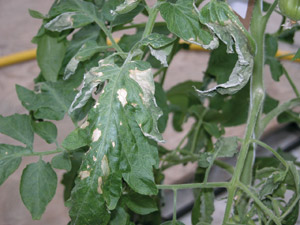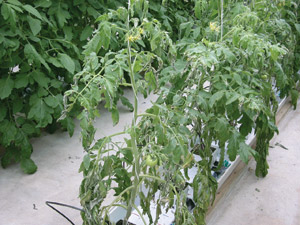
Features
Crop Protection
Inputs
Minimizing bacterial canker risk
November 3, 2008 By Gillian Ferguson
The bacteria that causes this chronically occurring disease of tomato crops survives much longer than you’d think
The bacteria that causes this chronically occurring disease of tomato crops survives much longer than you’d think
Bacterial canker, caused by Clavibacter michiganensis subsp. michiganensis, is a chronically occurring disease of tomatoes worldwide, and can cause significant losses in both field and greenhouse crops. An article written earlier this year focused on infection studies undertaken between 2004 and 2006 by Dr. Mike Tu, assisted by Barb Harwood, and in collaboration with the author of this article at the Greenhouse and Processing Crops Research Centre in Harrow, Ontario. This article provides results of survival studies carried out by the same workers to determine the importance of surface contamination as a means of disease carryover.

Typical scorch symptoms on leaf of tomato plant heavily infected with bacterial canker.
|
Because it was unclear how the various surfaces (e.g., plastic, concrete etc.) within a greenhouse might affect the survival of the canker bacteria, one trial was designed to investigate this question. In addition, because there was uncertainty regarding the survival of the organism in plant tissue and commonly used growing media, this topic was also investigated.
SURVIVAL OF CANKER BACTERIA ON VARIOUS SURFACES
Surfaces included in this study were styrofoam plug trays, white on black plastic, drywall cement, plastic seedling trays, and aluminum flashing. Surfaces of these materials were sprayed with a solution of the canker bacteria (10,000 bacteria/ml) to runoff, air-dried, placed in incubators held at one of three temperatures (5, 23, 29 ± 2ºC), and exposed to 14 hours of light. Samples of the various materials were removed regularly over several months and tested for live bacteria.
Observations indicated that survival was generally long on all surfaces and at all temperatures. Survival was highest until about four weeks after contamination. After this time, smaller numbers of bacteria could still be detected. For example, for the styrofoam trays held at 23ºC and 29ºC, some live bacteria could be detected at 16.5 weeks, and for all other materials, live bacteria were detected at least 16.5 weeks at all three temperatures used for this study. The longest survival was on greenhouse plastic and cement. Some bacteria survived on both of these surfaces for at least 30 weeks at all three temperatures.

Pronounced wilting symptoms in tomato plant infected with bacterial canker.
|
SURVIVAL OF CANKER BACTERIA IN PLANT DEBRIS AND ROCKWOOL
Two trials were done in which leaves, stems, roots of infected seedlings, and rockwool in which infected plants were grown, were examined for survival of the canker bacteria. Materials were stored at room temperature and sampled for live bacteria at intervals during periods of 52 and 71 weeks for the first and second trials, respectively.
For the first trial, we found that the canker bacteria survived at least 52 weeks in all materials; i.e., leaves, roots, stem, and rockwool. For the second trial, survival in the leaves was for 43 weeks, whereas for all other materials, survival lasted at least 71 weeks.
In summary, survival of the canker-causing bacteria on most surfaces is about one month for the most part. Long survival in debris and rockwool indicates the importance of removing all infected plant material and growing media to minimize carryover of bacterial canker to subsequent crops.
Acknowledgments: Partial funding provided by Ontario Greenhouse Vegetable Growers for this project is gratefully acknowledged.
Gillian Ferguson is the greenhouse vegetable IPM specialist with the Ontario Ministry of Agriculture, Food and Rural Affairs in Harrow. • 519-738-1258, or gillian.ferguson@ontario.ca
Print this page